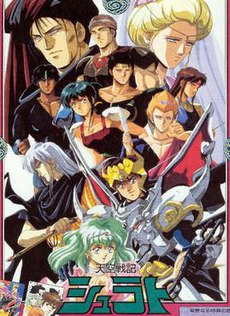Legend of Heavenly Sphere Shurato
This article needs additional citations for verification. (July 2012) |
| Legend of Heavenly Sphere Shurato | |||||||||||||||||||||||||||||||||||||||||||||||||||
 Promotional image for Legend of Heavenly Sphere Shurato | |||||||||||||||||||||||||||||||||||||||||||||||||||
| 天空戦記 シュラト (Tenkū Senki Shurato) | |||||||||||||||||||||||||||||||||||||||||||||||||||
|---|---|---|---|---|---|---|---|---|---|---|---|---|---|---|---|---|---|---|---|---|---|---|---|---|---|---|---|---|---|---|---|---|---|---|---|---|---|---|---|---|---|---|---|---|---|---|---|---|---|---|---|
| Genre | Action, fantasy, mythic | ||||||||||||||||||||||||||||||||||||||||||||||||||
| Created by | Hiroshi Kawamoto | ||||||||||||||||||||||||||||||||||||||||||||||||||
| Anime television series | |||||||||||||||||||||||||||||||||||||||||||||||||||
| Directed by | Mizuho Nishikubo | ||||||||||||||||||||||||||||||||||||||||||||||||||
| Produced by | Heita Ezu Michio Shimizu Masakatsu Kozuru Motoki Ueda | ||||||||||||||||||||||||||||||||||||||||||||||||||
| Written by | Mayori Sekijima Tatsunoko | ||||||||||||||||||||||||||||||||||||||||||||||||||
| Original network | TV Tokyo | ||||||||||||||||||||||||||||||||||||||||||||||||||
| Original run | April 6, 1989 – January 18, 1990 | ||||||||||||||||||||||||||||||||||||||||||||||||||
| Episodes | 38[1] | ||||||||||||||||||||||||||||||||||||||||||||||||||
| Original video animation | |||||||||||||||||||||||||||||||||||||||||||||||||||
| Dark Genesis | |||||||||||||||||||||||||||||||||||||||||||||||||||
| Directed by | Yoshihisa Matsumoto | ||||||||||||||||||||||||||||||||||||||||||||||||||
| Produced by | Ippei Kuri | ||||||||||||||||||||||||||||||||||||||||||||||||||
| Written by | Mayori Sekijima Mizuho Nishikubo Satoru Akahori | ||||||||||||||||||||||||||||||||||||||||||||||||||
| Music by | Hiroya Watanabe | ||||||||||||||||||||||||||||||||||||||||||||||||||
| Studio | Tatsunoko | ||||||||||||||||||||||||||||||||||||||||||||||||||
| Released | August 16, 1991 – March 16, 1992 | ||||||||||||||||||||||||||||||||||||||||||||||||||
| Episodes | 6 | ||||||||||||||||||||||||||||||||||||||||||||||||||
| |||||||||||||||||||||||||||||||||||||||||||||||||||
Legend of Heavenly Sphere Shurato (
Set in a parallel world called "Tenkūkai", which exists alongside Earth, evil forces known as the Asura Gods threaten to overcome the forces of good, causing the magical leader of this realm to transport warriors from Earth to their world. It's based on Hindu and Buddhist mythology.
Plot
The plot revolves around two boys, Shurato Hidaka and Gai Kuroki, lifelong best friends who are polar opposites of each other in appearance and personality. While fighting each other in a martial arts tournament, they are suddenly encased in a beam of light and transported to a parallel world, Tenkūkai, where modern technology does not exist and instead the people rely on Sohma, a form of spiritual energy.
Shurato discovers he is actually the reincarnation of an ancient king of the same name, who once ruled this world, and one of the "Hachibushu", a group of eight legendary warriors with large quantities of Sohma, and was brought here along with Gai to fight the Asura Gods, a legion of destructive warriors. However, for unknown reasons, Gai attempts to kill Shurato repeatedly, confusing Shurato as the real Gai is a pacifist and the most compassionate person he knows.
Things quickly go wrong when Shurato and another of the Hachibushu, Ten-ō Hyūga, are framed for the petrification of Lady Vishnu, a powerful divinity and the leader of the people of Tenkūkai. The actual culprit, Vishnu's highest advisor and Asura spy Indrah, and the corrupted Gai manage to convince the remainder of the Hachibushu, as well as all of Tenkūkai's warriors and soldiers, that Shurato and Hyūga are evil and must be killed.
Although at first reluctant to get involved, Shurato eventually resolves to aid Hyūga in uncovering the conspiracy and cure Vishnu. They are accompanied by the young Tenkūkai spirit priestess Lakshu, and two others of the Hachibushu, Ryū-ō Ryōma and Karura-ō Reiga. Along the way, they engage in battle with the other four of the Hachibushu, sinister Asura agents in league with Indrah, and the majority of Tenkūkai's population.
Characters
- Shurato Hidaka (日高秋亜人, Hidaka Shurato)
- (also Shura-Oh Shurato (修羅王シュラト, Shura-ō Shurato))
- The titular main protagonist of the series, Shurato, is a hot-headed, reckless, and impatient 16-year-old. He is depicted as having low tolerance and understanding of Tenkūkai's laws and inner workings, but is strong and pure-hearted. Like Gai, he is a martial arts master, and eventually becomes the most powerful of the Hachibushu and their de facto leader. His shakti and armor are both modeled after the lion, and his weapon is a vajra.
- Gai Kuroki (黒木凱, Kuroki Gai)
- (also Yasha-Oh Gai (夜叉王ガイ, Yasha-ō Gai))
- A primary character and one of the main antagonists of the show, Gai was Shurato's best friend on Earth, but became his greatest enemy in Tenkūkai when he was put in a spell by Indrah. Unlike Shurato, he is cool, collected, and highly intelligent. He was a martial arts master, depicted as Shurato's equal, even though he was also a pacifist. His shakti and armor are both modeled after the wolf, and his weapon is a longsword.
- Lakshu of Hōraisan (蓬莱山のラクシュ, Hōraisan no Rakushu)
- Based on the Hindu goddess Lakshmi, Lakshu is a young native of Tenkūkai and a fledgling spirit priestess. She is the first person to find Shurato after he is teleported to Tenkūkai, attempting to wake him up with a kiss. She then accompanies Shurato and Hyūga on their journey, and becomes a major asset to the team when her latent Sohma powers manifest.
Media
TV anime and OVA
The TV series premiered on TV Tokyo, where it ran for 38 episodes from April 6, 1989, to January 1990. It was
Theme songs
- Opening theme
- "Shining Soul" by Satoko Shimizu (epi. 01–25)
- "Truth" by Satoko Shimizu (epi. 26–38)
- "Keep Your Pure Love" by Satoko Shimizu (OVA 1–6)
- Ending theme
- "Sabaku no Meizu (Desert Labyrinth)" by Satoko Shimizu (epi. 01–25)
- "Caravan" by Satoko Shimizu (epi. 26–38)
- "Garasu no Shōnen (Glass Boy)" by Satoko Shimizu (OVA 1–6)
Manga and novels
The manga series was written by Hiroshi Kawamoto and illustrated by Kawamoto (characters and setting) and Todoroki Mihara (shaktis) and was serialized in
Mechanical designers
- Studio Ammonite(Hiroshi Ogawa, Hiroshi Okura, and Takashi Ono)
Notes
References
- ^ "Tatsunoko Pro". Tatsunoko.co.jp. Retrieved 2012-07-30.
- ^ "AT-X anime".
External links
- Tenku Senki Shurato (anime) at Anime News Network's encyclopedia
- Tenku Senki Shurato at IMDb
